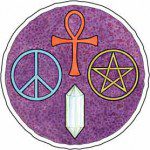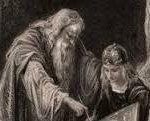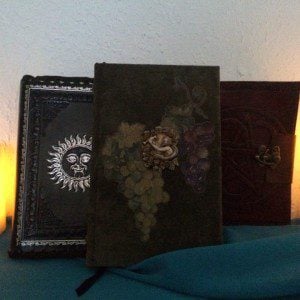 Few working tools sound more evocative than the Book of Shadows. It’s a title that simply sounds witchy, and instantly conjures up images of spell-craft kept secret for centuries. The phrase its self is less than 100 years old, but the idea of a “magic book” is centuries, perhaps millennia, old.
Few working tools sound more evocative than the Book of Shadows. It’s a title that simply sounds witchy, and instantly conjures up images of spell-craft kept secret for centuries. The phrase its self is less than 100 years old, but the idea of a “magic book” is centuries, perhaps millennia, old.
Up until the early 1970’s the only way to get ahold of Witch-ritual (outside of making up one’s own) was to be initiated into a coven and/or tradition. While today’s Books of Shadow vary in content and definition, forty and fifty years ago they weren’t just the transmission of a tradition they were the only “how to” books available! Receiving Witch-rituals from a BoS not only signified being an initiate it was a sacred trust. As Modern Witchcraft evolved beyond the “initiate only” structure the definition of BoS was expanded for solitaries.
The phrase Book of Shadows can have several meanings depending on context, and I personally have (and use) several different BoS’s depending on what type of ritual I’m taking part in. Generally a Book of Shadows refers to an individual Witch’s collection of spells and rituals, though this can vary. Most BoS’s fit somewhere into the following three categories:
1. A traditional coven’s working rituals and instructions about their specific practice. Usually a coven’s BoS can only be added to by the High Priestess or High Priest. In addition to spells and rituals a BoS of this type sometimes contain poetry and chants. A BoS kept by a coven might also include rites of passage.
2. A collection of spells and rituals by a working Witch. If one is a solitary then this type of BoS mostly sums up their individual practice. If the individual Witch is part of a tradition they may have a personal BoS designed to supplement the BoS of their coven and/or tradition. Sometimes a BoS of this type is referred to as a “cook book.”
3. A Witch’s diary or dream journal, perhaps supplemented with additional material. This is not a definition of the BoS that I’m comfortable with, but I’ve seen such magical journals labeled as a BoS in some books and online materials.
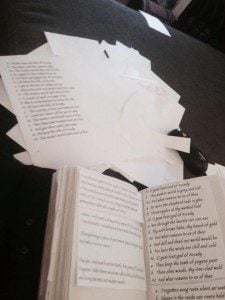 My house currently has five very different BoS’s in it. My first BoS is a collection of spells, rituals, and poems that I began putting together 15 years ago. Everything in that book is written by (my mostly illegible) hand. It’s my prettiest BoS and the one I feel most attached to since I’ve had it longer than any of the others. My wife has one of a similar nature. Recently I purchased a new BoS specifically to place sabbat rituals in. Instead of copying those rituals down by hand it mostly consists of printouts glued into my book with rubber cement. It’s an impressive looking book, and far more legible than my first BoS.
My house currently has five very different BoS’s in it. My first BoS is a collection of spells, rituals, and poems that I began putting together 15 years ago. Everything in that book is written by (my mostly illegible) hand. It’s my prettiest BoS and the one I feel most attached to since I’ve had it longer than any of the others. My wife has one of a similar nature. Recently I purchased a new BoS specifically to place sabbat rituals in. Instead of copying those rituals down by hand it mostly consists of printouts glued into my book with rubber cement. It’s an impressive looking book, and far more legible than my first BoS.
My current (non-traditional) coven has its own BoS full of ritual, poetry, and other odds and ends that I thought were useful. It also includes an explanation of the ritual we use and some extended histories on things like The Charge of the Goddess. It’s contents are not an oathbound secret (and it does include a few Raise the Horns articles, like this one on the Wiccan Rede), but we don’t widely share it with a whole lot of folks. I also have part of a BoS from a tradition I’m initiated into which stays locked up and out of sight.
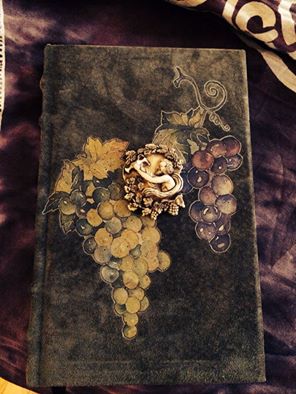 The non-traditional coven’s BoS was assembled on a desktop computer and then printed in book form. This is probably not typical of most BoS’s today but appealed to me. Many people still write and/or copy their BoS’s by hand (paper and ink), and the practice is still required in some traditional covens. I had a roommate who worked at Kinko’s (now FedEx) years ago and his BoS was almost all photocopied directly from books and magazines. Written, copied, printed, or pasted, what’s most important in a BoS is functionality. As long as it works for the individual Witch or coven it’s probably fair game.
The non-traditional coven’s BoS was assembled on a desktop computer and then printed in book form. This is probably not typical of most BoS’s today but appealed to me. Many people still write and/or copy their BoS’s by hand (paper and ink), and the practice is still required in some traditional covens. I had a roommate who worked at Kinko’s (now FedEx) years ago and his BoS was almost all photocopied directly from books and magazines. Written, copied, printed, or pasted, what’s most important in a BoS is functionality. As long as it works for the individual Witch or coven it’s probably fair game.
I will admit there’s a certain magic involved with writing out parts of a BoS. A coven-mate of mine recently gave me a new BoS (it’s the one with grapes and Pan on it) and I’m planning to write out my coven’s opening and closing ritual on its pages. Not only does writing provide a link to earlier times, it also serves to help reinforce the material one is jotting down. There’s a reason teachers made us copy things when we were kids, and one of the best ways to commit something to memory is by writing it down. I can’t imagine writing down everything in my current BoS’s, but I do want some of my rituals in my own handwriting. (Ritual in my own handwriting is nearly the equivalent of writing in cypher.)
Many BoS’s are elaborate constructions or at least “pretty books” but with a BoS functionality is always more important than looks. In fact a rather nondescript looking BoS has certain advantages; no one is going to “accidentally” pick up your BoS if they think it’s a collection of old college notes! I was with a friend recently and she showed me one of her BoS’s that she kept in a three ring binder. The binder allowed her to take things out of her book and then move them around wherever (and whenever) she wanted (very practical!). My first BoS was designed to be a journal and not a collection of rituals and spells. One can basically use anything as a BoS.
The term Book of Shadows is of rather recent vintage first showing up in magical works in 1949. It’s most celebrated appearance that year was in Gerald Gardner’s High Magic’s Aid, a fiction novel that contained elements of Modern Witchcraft. Before Gardner’s novel the term also appeared in a copy of the Occult Observer (magazine) where it was used to refer to a book about Sanskrit divination. Both the magazine and the book shared the same publisher (Michael Houghton) the then owner of the Atlantis Bookshop in London. (1)
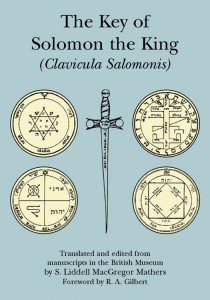 Ancient pagan religions had their own “secret books” (or scrolls) of ritual, which is one of the reasons so few intact ancient rites from that era exist today. Often those books were limited to temple priests. The Medieval Period saw the rise of the grimoire, usually a collection of spells and ceremonies. Early grimoires were often copied by hand and then passed down over the generations. With the arrival of the printing press many of those grimoires went into print, and were then followed by additional titles.
Ancient pagan religions had their own “secret books” (or scrolls) of ritual, which is one of the reasons so few intact ancient rites from that era exist today. Often those books were limited to temple priests. The Medieval Period saw the rise of the grimoire, usually a collection of spells and ceremonies. Early grimoires were often copied by hand and then passed down over the generations. With the arrival of the printing press many of those grimoires went into print, and were then followed by additional titles.
The most famous Renaissance era grimoire is probably The Key of Solomon, a collection of ceremonial magic falsely attributed to King Solomon and probably put together sometime in the 14th Century. Within 200 years of its composition it was being published in several different languages and also continued to be copied by hand. (The exact number and influence of “magic books” can often be hard to determine because of how often they, and pieces of them, were copied by hand. Magic books rarely went out of print, but depending on location they could be difficult to get.) Magicians who used The Key often wrote copious notes in the book’s margins, a practice that was popular with many folks who used magic books. The popularity of the Key of Solomon has continued into the present day and shows up in Gardner’s High Magic’s Aid. The most common translation today is that of Liddell MacGregor Mathers from 1889.
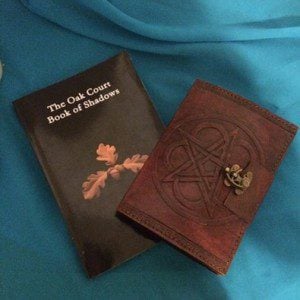 Books of magic were especially popular among English Cunning-folk. Their traditions were just as likely to be from books as they were from oral sources. They too often wrote in the margins, and sometimes collected their wisdom and practices in personal books that were then passed on from generation to generation. Such personal books contained information gleaned from other printed materials, oral sources, and individual trial and error.
Books of magic were especially popular among English Cunning-folk. Their traditions were just as likely to be from books as they were from oral sources. They too often wrote in the margins, and sometimes collected their wisdom and practices in personal books that were then passed on from generation to generation. Such personal books contained information gleaned from other printed materials, oral sources, and individual trial and error.
The Pennsylvania Dutch grimore The Long Lost Friend (wrtten by Joh Hohman and first published, in German, in 1820) was one of America’s earliest grimoires and is still influential nearly two hundred years later. Some of the spells within it were hundreds of years old at the time of its initial publication. Like many magic books The Friend was thought to contain its own power and many believed that keeping a copy on one’s person could prevent physical harm.
What’s interesting to me about about the history of grimoires and other magical books is that it shows that the Book of Shadows is not a modern invention. If anything it’s a direct continuation of a tradition that is centuries old. The name might be rather new but not the ideas behind it.
However one chooses to utilize a Book of Shadows, what’s most important is that its contents speak directly to the individual Witch. The materials in all of my BoS’s are sacred to me, but not in a fundamentalist, crazy sort of way. Every BoS is a product of the human hand and mind and because of that isn’t an infallible document. One of the best things about Witchcraft is that it offers every Witch an individual path to the divine, a good BoS documents that journey and offers some help along the way, but can’t take you there on its own.
If you enjoyed this article you might also like Witches Toolbox: Athame. (Actually you’ll probably like that one even better!)
1. Wicca: Magical Beginnings by Sortia d’Este and David Rankine. Avalonia Press, 2008. page 44
2. Triumph of the Moon by Ronald Hutton, Oxford University Press, 1999. page 92
Do you like Raise the Horns? Even if you don’t how about humoring a harmless blond-haired guy? Like RtH on Facebook, and also like Patheos Pagan for more great articles most of them far better than this one. Are you a Pagan living in the UK? Jason will be in London and Edinburgh this September and October, send him a message if you’d like to get a cup of tea or a pint of cider.


